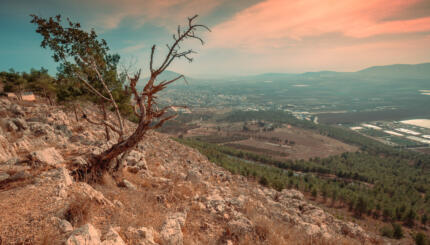Commentary on Parashat Metzora, Leviticus 14:1 - 15:33
Leprosy is not bad enough. Whatever is being described in this week’s Torah portion as tzaraat (generally translated as leprosy but probably not so), it is clear that this malady has the pernicious power to transcend its insidious attack on the body and spread into garments and penetrate the walls of homes. The Torah wants the reader to understand that this is not a creeping bacterium.
Rather, tzaraat is a spiritual malaise that manifests itself as a disease of the body or some kind of mold-like substance that can infiltrate the walls of our homes. Perhaps it is even more life-threatening as a result, because it can destroy the soul.
That’s why the Torah charges the priest (spiritual leader) as the only one in the community empowered to make the diagnosis and in a position to take the individual through the process of ritual purification. During this process of ritual cleansing, the priest generally sequesters the individual (outside of the camp) and may even remove the stones from the wall of the house if he is unable to completely cleanse them or if the disease surfaces again unabated.
Outside the Camp
This seems like the way that the Torah deals with many of its challenges and has thereby taught the Jewish community to do the same when it faces any kind of a threat, especially one that it doesn’t fully understand: just place those who are involved outside of the camp. After all, that is where azazel exists; it might even be where gehinom is–outside of the camp, outside of the embrace of the community, anyplace that is not within the orbit of the people.
If we don’t see them, then perhaps they don’t really exist. At the very time that people are in need of others, the community is directed to abandon them or, at least, place them out of sight. The social visibility factor, as sociologists might name it, just provokes too much of anxiety to do anything else. Maybe it is just fear of the “other” that drives the process. Nevertheless, the result is the same: placing distance between the individual and the community.
Embracing the Other
Yet there’s more going on than that, and in fact the Torah contains a counter message. In this week’s portion, the priest takes on the tzaraat as part of the process of healing. This demonstrates the power of leadership and its potential to model the correct approach, in part–to embrace the other, rather than to just push them away.
There are many outside the camp today, that is, outside of the core Jewish community. Some have chosen that path. Others have been pushed out–especially by the community’s leadership, however unintentional it might have been.
I wonder what would have happened had the people in the Torah embraced those whom they saw as stricken with the malady of tzaraat rather than forcing them to live outside the camp. I wonder what would have happened had the priest refused to place them outside of the camp and instead helped the people to understand that the Jewish community cannot and should not act that way. I wonder what would happen today in the Jewish community were we to embrace those on the periphery rather than forcing them even further away.
The Contemporary Challenge
I am reminded of a graduate and now spokeswoman of our Mothers Circle program–for women of other religious backgrounds raising Jewish children–who receives the same first question whenever she presents to Jewish groups: if she is already leading a Jewish life, why not just convert to Judaism?
She responds, “Perhaps had the community and my future in-laws embraced me when I first started dating my husband, I might have done just that. But they didn’t. They pushed me away. And now I question whether I will ever be fully accepted, even as a convert.” When we embrace with one hand but push away with the other, it’s the push that remains the lasting memory.
This Torah portion occurs in Leviticus, the book of the Torah that is so core to Jewish communal life that it is studied first in classical Jewish curricula. Its behaviors–the rules and regulations that generally guide us as a community–set the foundation for what follows. So it is Leviticus that informs all of the books in the Torah. Should it not be the one to guide us in relating to the growing numbers of those who are on the fringe of the community?
But the general sense of Leviticus is contained in this statement: “The stranger that lives with you shall be to you like the native, and you shall love him [or her] as yourself; for you were strangers in the land of Egypt. I am the Lord your God” (Leviticus 19:34) rather than in the notion to push people away. The Torah provides us with options, two different approaches in Leviticus.
So rather than pushing away as the Torah recorded the ancient actions of our ancestors regarding those with tzaraat, let us open our tent wider to allow them in. Why? Because meaningful Jewish life is not found outside of the community. It is found in our midst. That is why we have chosen to live here. It is finally time to make room for others to do so as well. Our future as a Jewish community depends on it.
Provided by the Jewish Outreach Institute, an organization dedicated to creating a more open and welcoming Judaism.
Torah
Pronunced: TORE-uh, Origin: Hebrew, the Five Books of Moses.


